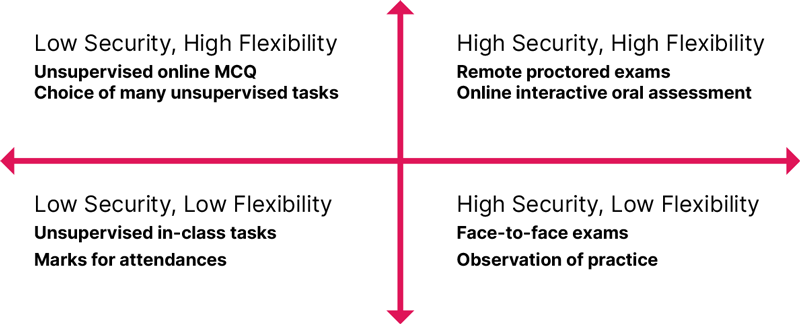
The challenge of conducting secure, authentic and scalable assessments is one faced by higher education institutions all over the globe. Whilst the digital revolution in assessments is moving at pace, institutions are travelling at different speeds as decision makers grapple with the best way forward.
It’s not surprising that the question of how institutions conduct digital assessments is undergoing serious analysis. We’ve just emerged from a period of enforced digitisation and many institutions are evaluating ways to solidify their digital assessment strategy while upholding academic standards. This dilemma is the springboard for our whitepaper “How do we balance assessment security and flexibility in e-assessments” in which we team up with EduGrowth and Professor Phillip Dawson from CRADLE (Centre for Research in Assessment and Digital Learning) at Deakin University Australia to explore how digital assessments can offer students the flexibility they crave and academic institutions the security they need.
A student’s perspective
Students have been asking for more flexibility but delivering this securely is one of the largest challenges facing institutions today. Freedom invariably means shifting more responsibility to the student. They want assessments that meet their needs and evaluate the skills they will require in the workplace. Ideally, institutions will offer an element of autonomy and choice – be that about location, time, style of questions, the weight of specific questions or the device used.
Without this freedom, it can lead to students feeling that academic malpractice is the only solution to achieving success. Alternatives such as assignment outsourcing, online sharing of test answers and the use of artificial intelligence to produce written tasks can present themselves as the only option. Studies conducted prior to the pandemic show that around 15% of students have paid someone to do their assignments, with these numbers growing.
A testing tightrope
This tightrope between flexibility and security is one educational institutions must cross and the good news is there are solutions that can help steady that path, including:
- Academic Integrity: A positive, educative and values-based approach to addressing malpractice, that can include signing an honour code or helping to develop student skills such as referencing or learning practices.
- Assessment Security: Monitoring student compliance and limiting attempts to break rules. This can include remote proctoring, randomising test questions and updating assessments annually.
Perhaps unsurprisingly, research shows that human contact reduces the likelihood of malpractice. This doesn’t mean digital assessments are more prone to malpractice, just that we have to be smarter in how we deliver them.
Ten steps to smarter assessments
We’ve identified ten considerations for finding the right balance between flexibility and security. Here are three I’d like to highlight, but you can read more about these and the other seven factors in more detail here.
1. Authentic assessments deliver authentic outcomes
Students conduct their lives online and when they enter the workforce the majority of their tasks will be digitally managed in some way. It makes sense that a digital approach is now the most authentic means of assessment. As we have mentioned, students also don’t want to be constrained by rules that don’t reflect the real world. For example, if a student is allowed access to reference materials in the workplace of their chosen profession, shouldn’t they be allowed the same during an assessment? Restrictions should only be in place if they are absolutely necessary and they must apply to everyone being assessed.
2. Smarter tests for a longer shelf life
It’s an unfortunate fact that assessments with a finite range of answers – such as multiple-choice exams – can be easily and anonymously shared online thanks to sites such as Chegg, Course Hero and Quizlet. Smarter and more adaptive assessments give your questions a longer shelf life by incorporating techniques such as multiple banks of questions, randomised or customised questions, or a larger variety of possible question combinations.
3. Innovation comes from collaboration
Although students are generally enthusiastic about digital assessment, when talking about making changes to the way assessments are conducted, we’re inviting academics, learning designers, media producers, exams teams and even senior university leadership to the table. Some might be happier to cautiously watch while other institutions take the lead in driving digital forward. At the same time, they don’t want to fall behind; collaboration across all parties is key.
The high flexibility, high security sweet spot
By placing assessments into quadrants, you can see which score highly on flexibility and security – and crucially which achieve high levels of both.

You might have faculties that work completely differently from each other. This quadrant allows them to identify which assessments fit the high security, high flexibility criteria and iron out the challenges we’ve identified. A flexible and configurable platform helps transform their assessment processes, enabling them to mark faster, enrol students more easily and assess their learning more accurately, freeing up time for them to spend on what they probably want to do more than anything – teach.
To dive into all ten key considerations for efficient and effective digital assessments, read the full whitepaper.



